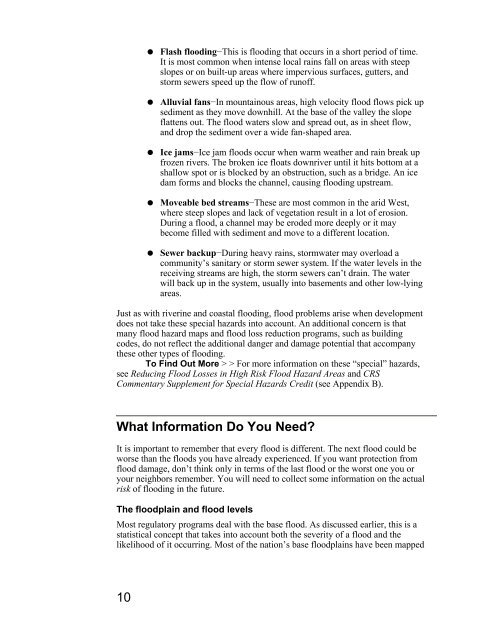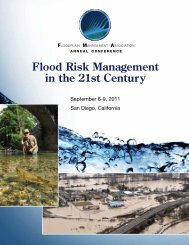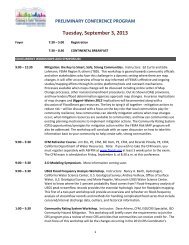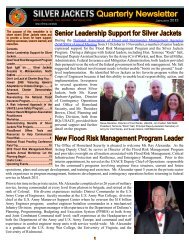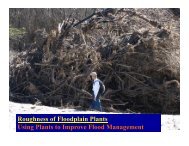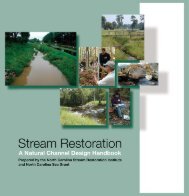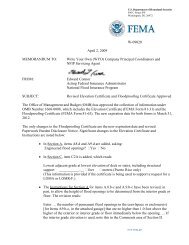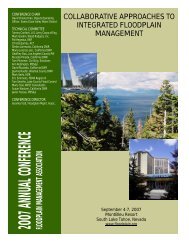Using Multi-Objective Management to Reduce Flood Losses in Your
Using Multi-Objective Management to Reduce Flood Losses in Your
Using Multi-Objective Management to Reduce Flood Losses in Your
You also want an ePaper? Increase the reach of your titles
YUMPU automatically turns print PDFs into web optimized ePapers that Google loves.
Flash flood<strong>in</strong>g−This is flood<strong>in</strong>g that occurs <strong>in</strong> a short period of time.<br />
It is most common when <strong>in</strong>tense local ra<strong>in</strong>s fall on areas with steep<br />
slopes or on built-up areas where impervious surfaces, gutters, and<br />
s<strong>to</strong>rm sewers speed up the flow of runoff.<br />
Alluvial fans−In mounta<strong>in</strong>ous areas, high velocity flood flows pick up<br />
sediment as they move downhill. At the base of the valley the slope<br />
flattens out. The flood waters slow and spread out, as <strong>in</strong> sheet flow,<br />
and drop the sediment over a wide fan-shaped area.<br />
Ice jams−Ice jam floods occur when warm weather and ra<strong>in</strong> break up<br />
frozen rivers. The broken ice floats downriver until it hits bot<strong>to</strong>m at a<br />
shallow spot or is blocked by an obstruction, such as a bridge. An ice<br />
dam forms and blocks the channel, caus<strong>in</strong>g flood<strong>in</strong>g upstream.<br />
Moveable bed streams−These are most common <strong>in</strong> the arid West,<br />
where steep slopes and lack of vegetation result <strong>in</strong> a lot of erosion.<br />
Dur<strong>in</strong>g a flood, a channel may be eroded more deeply or it may<br />
become filled with sediment and move <strong>to</strong> a different location.<br />
Sewer backup−Dur<strong>in</strong>g heavy ra<strong>in</strong>s, s<strong>to</strong>rmwater may overload a<br />
community’s sanitary or s<strong>to</strong>rm sewer system. If the water levels <strong>in</strong> the<br />
receiv<strong>in</strong>g streams are high, the s<strong>to</strong>rm sewers can’t dra<strong>in</strong>. The water<br />
will back up <strong>in</strong> the system, usually <strong>in</strong><strong>to</strong> basements and other low-ly<strong>in</strong>g<br />
areas.<br />
Just as with river<strong>in</strong>e and coastal flood<strong>in</strong>g, flood problems arise when development<br />
does not take these special hazards <strong>in</strong><strong>to</strong> account. An additional concern is that<br />
many flood hazard maps and flood loss reduction programs, such as build<strong>in</strong>g<br />
codes, do not reflect the additional danger and damage potential that accompany<br />
these other types of flood<strong>in</strong>g.<br />
To F<strong>in</strong>d Out More > > For more <strong>in</strong>formation on these “special” hazards,<br />
see Reduc<strong>in</strong>g <strong>Flood</strong> <strong>Losses</strong> <strong>in</strong> High Risk <strong>Flood</strong> Hazard Areas and CRS<br />
Commentary Supplement for Special Hazards Credit (see Appendix B).<br />
What Information Do You Need<br />
It is important <strong>to</strong> remember that every flood is different. The next flood could be<br />
worse than the floods you have already experienced. If you want protection from<br />
flood damage, don’t th<strong>in</strong>k only <strong>in</strong> terms of the last flood or the worst one you or<br />
your neighbors remember. You will need <strong>to</strong> collect some <strong>in</strong>formation on the actual<br />
risk of flood<strong>in</strong>g <strong>in</strong> the future.<br />
The floodpla<strong>in</strong> and flood levels<br />
Most regula<strong>to</strong>ry programs deal with the base flood. As discussed earlier, this is a<br />
statistical concept that takes <strong>in</strong><strong>to</strong> account both the severity of a flood and the<br />
likelihood of it occurr<strong>in</strong>g. Most of the nation’s base floodpla<strong>in</strong>s have been mapped<br />
10


